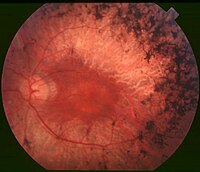
Photo from wikipedia
PURPOSE To describe the natural disease course of CRB1-associated retinal dystrophies, and to identify clinical endpoints for future clinical trials. DESIGN Single center, prospective case series. METHODS An investigator-initiated nationwide… Click to show full abstract
PURPOSE To describe the natural disease course of CRB1-associated retinal dystrophies, and to identify clinical endpoints for future clinical trials. DESIGN Single center, prospective case series. METHODS An investigator-initiated nationwide collaborative study that included 22 patients with CRB1-associated retinal dystrophies. Patients underwent ophthalmic assessment at baseline and 2 years after baseline. Clinical examination included best-corrected visual acuity (BCVA) using ETDRS charts, Goldmann kinetic perimetry (V4e isopter seeing retinal areas), microperimetry, full-field electroretinography (ERG), full-field stimulus threshold (FST), fundus photography, spectral-domain optical coherence tomography and fundus autofluorescence imaging. RESULTS Based on genetic, clinical and electrophysiological data, patients were diagnosed with retinitis pigmentosa (n = 19; 86%), cone-rod dystrophy (n = 2; 9%) or isolated macular dystrophy (n = 1; 5%). Two-year analysis of the entire cohort showed no significant changes in BCVA (p = 0.069) or V4e isopter seeing retinal areas (p = 0.616), although signs of clinical progression were present in individual patients. Macular sensitivity measured on microperimetry revealed a significant reduction at 2-year follow-up (p < 0.001). FST responses were measurable in patients with non-recordable ERGs. On average, FST responses remained stable during follow-up. CONCLUSION In CRB1-associated retinal dystrophies, visual acuity and visual field measures remain relatively stable over the course of 2 years. Microperimetry showed a significant decrease in retinal sensitivity during follow-up, and may be a more sensitive progression marker. Retinal sensitivity on microperimetry may serve as a functional clinical endpoint in future human treatment trials for CRB1-associated retinal dystrophies.
Journal Title: American journal of ophthalmology
Year Published: 2021
Link to full text (if available)
Share on Social Media: Sign Up to like & get
recommendations!